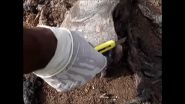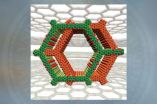(Press-News.org) Autopsies have shown that some high-profile athletes who suffered repeated blows to the head during their careers have unusual protein clumps in their brains. Those clumps suggest the athletes had a disease called chronic traumatic encephalopathy (CTE). Now, scientists are working on tests that might be able to detect CTE in its earliest stages, according to an article in Chemical & Engineering News (C&EN), the weekly news magazine of the American Chemical Society.
In the article, Lauren Wolf, a senior editor at C&EN, explains that many of these athletes struggled with symptoms such as memory loss, depression and violent mood swings while they were alive. One professional wrestler, Chris Benoit — who was known for slamming his head into competitors — murdered his wife and son and then took his own life in 2007. An autopsy confirmed that he had clumps of a protein in his brain that are characteristic of CTE. Scientists studying the disease suspect that, like Alzheimer's, CTE takes root even before symptoms arise. Also, as in Alzheimer's, CTE diagnoses can only be confirmed after a patient dies, and a medical professional examines the brain. So, scientists recently set out to learn more about this puzzling disease.
Several groups have started studying retired and active athletes to see if they can find biological clues to detect the disease while the athletes are still alive. To do this, they're using different forms of brain imaging, including MRI and PET scans. If they succeed, they'll have new tools to help guide athletic rules and manage athletes' health in the future.
INFORMATION:
The American Chemical Society is a nonprofit organization chartered by the U.S. Congress. With more than 161,000 members, the ACS is the world's largest scientific society and a global leader in providing access to chemistry-related research through its multiple databases, peer-reviewed journals, and scientific conferences. Its main offices are in Washington, D.C., and Columbus, Ohio.
To automatically receive news releases from the American Chemical Society, contact newsroom@acs.org.
Follow us: Twitter
Facebook
Detecting concussion-related brain disease in its earliest stages
2014-07-24
ELSE PRESS RELEASES FROM THIS DATE:
Dead-body-feeding larvae useful in forensic investigations
2014-07-24
VIDEO:
This image depicts Chrysomya megacephala larvae on decomposing fish.
Click here for more information.
Non-biting blow fly Chrysomya megacephala is commonly found in dead bodies and is used in forensic investigations to determine the time of death, referred to as the post mortem interval. A report of synanthropic derived form of C. megacephala from Tamil Nadu is provided for the first time based on morphological features and molecular characterization through generation ...
Nearly 50 years of lemur data now available online
2014-07-24
VIDEO:
Duke Lemur Center had made 48 years of primate data available online.
Click here for more information.
DURHAM, N.C. -- A 48-year archive of life history data for the world's largest and most diverse collection of endangered primates is now digital and available online. The Duke Lemur Center database allows visitors to view and download data for more than 3600 animals representing 27 species of lemurs, lorises and galagos -- distant primate cousins who predate monkeys ...
New mass map of a distant galaxy cluster is the most precise yet
2014-07-24
Astronomers using the NASA/ESA Hubble Space Telescope have mapped the mass within a galaxy cluster more precisely than ever before. Created using observations from Hubble's Frontier Fields observing programme, the map shows the amount and distribution of mass within MCS J0416.1-2403, a massive galaxy cluster found to be 160 trillion times the mass of the Sun. The detail in this mass map was made possible thanks to the unprecedented depth of data provided by new Hubble observations, and the cosmic phenomenon known as strong gravitational lensing.
Measuring the amount and ...
University of Delaware researcher describes new approach for creating organic zeolites
2014-07-24
Yushan Yan, Distinguished Professor of Engineering at the University of Delaware, is known worldwide for using nanomaterials to solve problems in energy engineering, environmental sustainability and electronics.
His early academic work focused on zeolites, porous rock with a well-defined, crystalline structure. At the atomic scale, their pore size is so precisely decided that zeolites can separate molecules with size differences of merely a fraction of an angstrom (one-tenth of a nanometer), making them useful to the chemical and petroleum industries as molecular sieves ...
Background TV can be bad for kids
2014-07-24
Parents, turn off the television when your children are with you. And when you do let them watch, make sure the programs stimulate their interest in learning.
That's the advice arising from University of Iowa researchers who examined the impact of television and parenting on children's social and emotional development. The researchers found that background television—when the TV is on in a room where a child is doing something other than watching—can divert a child's attention from play and learning. It also found that non-educational programs can negatively affect children's ...
Wireless home automation systems reveal more than you would think about user behavior
2014-07-24
This news release is available in German.
Home automation systems that control domestic lighting, heating, window blinds or door locks offer opportunities for third parties to intrude on the privacy of the inhabitants and gain considerable insight into their behavioral patterns. This is the conclusion reached by IT security expert Christoph Sorge and his research team at Saarland University. Even data transmitted from encrypted systems can provide information useful to potential burglars. Professor Sorge, who holds the juris Professorship in Legal Informatics ...
Natural products from plants protect skin during cancer radiotherapy
2014-07-24
Radiotherapy for cancer involves exposing the patient or their tumor more directly to ionizing radiation, such as gamma rays or X-rays. The radiation damages the cancer cells irreparably. Unfortunately, such radiation is also harmful to healthy tissue, particularly the skin over the site of the tumor, which is then at risk of hair loss, dermatological problems and even skin cancer. As such finding ways to protect the overlying skin are keenly sought.
Writing in the International Journal of Low Radiation, Faruck Lukmanul Hakkim of the University of Nizwa, Oman and Nagasaki ...
Identified a key molecule in flies that adjusts energy use under starvation conditions
2014-07-24
Most scientific literature devoted to the protein p53 refers to cancer biology, and the functions of this molecule as a tumour suppressor have been described in detail. Furthermore, also in cancer biology, it is known that p53 inhibits the metabolic pathways of tumour cells in order to block their metabolism and prevent their rapid growth and proliferation.
The most innovative research on p53 attempts to unveil its functions in the management of energy stores and nutrients in healthy cells. Recent studies with cell cultures have demonstrated that p53 is activated in response ...
Metastatic brain tumor treatment could be on the horizon with use of SapC-DOPS
2014-07-24
CINCINNATI -- Over half of patients being seen in the clinic for a diagnosed brain tumor have metastatic cancer, which has no treatment and detrimental outcomes in most cases.
However, a Cincinnati Cancer Center (CCC) study, published in the advance online edition of the journal Oncotarget, provides hope that previously studied SapC-DOPS could be used for treatment of brain cancer that has spread.
Xiaoyang Qi, PhD, member of the CCC, associate director and associate professor in the division of hematology oncology at the University of Cincinnati (UC) College of Medicine ...
Seeing the same GP at every visit will reduce emergency department attendance
2014-07-24
Attendances at emergency departments can be reduced by enabling patients to see the same GP every time they visit their doctor's surgery. This is just one of several recommendations made in a report published today, led by researchers at the University of Bristol.
Called 'Primary care factors and unscheduled secondary care: a series of systematic reviews', the report has been compiled by researchers from the University's Centre for Academic Primary Care who looked at evidence from studies around the world. They found that patients who saw the same GP every time they attended ...






